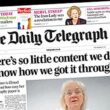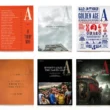What’s the future of the news business? As if the continuous bleeding of daily newspapers was not enough, the bright young things of digital news are also in crisis. Thousands of people have been laid-off at BuzzFeed, Vice, Vox, Mic, and Huffington Post. It is easy to see that news has become a much smaller business with a profitability that, at the very best, will not satisfy most of the companies made powerful by a golden century of daily newspapers – and nowhere near the scale of digital-only companies that once seemed sustainable.
The need now to depend on reader revenues more than advertising is one obstacle but, equally challenging, is the drive for entirely new digital business models rather than tweaking those that served publishers so well in print. The defining issue of all digital media is that reader-users-viewers can be persuaded to pay but only really for exclusive content they cannot find anywhere else.
The generally-available news that continues to dominate the print and digital output of daily news brands will not cut it, especially when sold as part of an indivisible bundle. It is 18 years since iTunes started selling individual songs instead of whole albums, and yet most dailies stick with the all-or-nothing bundle even in digital – because they are trying to defend their print profits. Newspapers are left to contemplate a future of being squeezed both by the digital behemoths and the agile specialists. It’s a fate that once befell medium-sized airlines, squashed between world leaders and budget carriers. For most news media, the future is all about targeting a niche not the Facebook mass market.
The latest candidate aiming for specialist success is Tortoise Media, being launched in the UK as a “slow news” publisher of a daily smartphone edition of five stories. The service, which invites readers to attend editorial meetings and plans to publish a quarterly print magazine of “big reads”, is headed by James Harding, former editor-in-chief of The Times and of the BBC, and former Wall Street Journal president Katie Vanneck-Smith. Their manifesto is clear enough: “We hope that, if we take a little longer and open up the process of journalism, we can better understand these problems and foster new ideas. We’re trying to come to a better informed point of view on our future. In that sense, we’re journalism as a jury, with a hell of a caseload.”
Tortoise went live with a daily newsletter in January (published, pointedly, at 11am London time, rather than for the start-of-day commuter journey) and launches formally in April. Statutory filings show it has raised some £6m from a combination of crowd funding and well-heeled individuals including former US Ambassador in London (and chief Obama fundraiser) Mathew Barzun.
Vanneck-Smith says: “Slow news sums up a way of looking at the world – critically but reflectively and, wherever we can, optimistically. As humans, we can’t possibly see everything. So we’re not going to cover everything – part of being slow is about making choices, and taking our time to make those choices… making sure that as many people as possible are proactively engaged in contributing to the answers in a meaningful way, not just a vox pop thrown together on a street corner. You can’t do that in the normal news cycle.”
The editorial meetings, to which members are invited and guests can pay to £25 to attend, are a fascinating experiment: “It is a forum for civilised disagreement. Modelled on what we call a ‘leader conference’ in the UK (or an editorial board in the US), it is a place where everyone has a seat at the table. It’s where we get to hear what you think, drawn from your experience, energy and expertise. It’s where, together, we sift through what we know to come to a clear, concise point of view. It is the heart of what we do at Tortoise.”
You sense that the insightful and well-written Tortoise has been inspired by the “explainer journalism” of Vox and Quartz and also by Axios, another US news startup from the founder of Politico which claims to have “almost” reached breakeven on advertising alone within two years of launch, ahead of a subscription product launch. But it also chimes with Jessica Lessin’s neatly-profitable The Information, with which it shares an emphasis on content quality not quantity, subscriptions, and no advertising. Tortoise’s soft-voice informality and its enthusiasm for reader interaction echoes The Information’s sense of community.
When it comes to the hard financials, Harding’s 40-person team (30 of them journalists, including some UK stars) may bring annual costs to some £5m. With 6k current subscribers paying an average of £70, the company might expect to reach 20k subscribers soon after launch and perhaps 30k within 12 months.
If so, annualised income would be some £2-3m, producing an initial operating deficit of perhaps £2-3m per year after launch. So, even without any additional debt, the shareholders’ initial £5.8m can give the company up to three years of funding. So far so good. But they’ve got to get and keep those subscriptions, and there are plans to expand the staff and also to internationalise the service. So, Tortoise may be budgeting for a much quicker subscriptions build-up. It is, though, projecting a break-even at 80-120k subscriptions – comparable with the 190-year-old UK political weekly The Spectator and the stylish digest The Week. This subscriptions target (which would produce annual revenues of some £6-7m) seems a bit steep.
Not everyone will agree with one existing Tortoise subscriber who says: “It’s the news equivalent of dipping your head in a cool, glacier-fresh stream on a scorching-hot day.” But the experienced team is full of pre-launch euphoria. Despite familiar warnings that journalists often don’t make brilliant business people and some inevitable sniffiness about James Harding’s news idealism, Tortoise’s millennial-skewed audience will get the attention of UK newspapers. It will also help to illuminate the uniquely high-value of the opinion pages in quality daily newspapers – which is what Tortoise is (sort of) trying to be.
This launch might, therefore, motivate some dailies somewhere to try packaging up their op-ed pages for a digital audience that doesn’t want all the news. Harding’s old paper The Times will jealousy guard its hard-won 140k subscriptions (out of a total daily circulation of 400k) with price and content wars if it starts to feel threatened.
You wonder whether solid progress by Tortoise might even prompt a group of columnists to band together to offer their own direct-to-reader subscription service. Or some may defect to Tortoise. Any such shifts could leave some newspapers and magazines looking a bit, well, naked. Will Tortoise help to kick-start the unbundling of daily news media? It might just galvanise the UK’s vintage news brands.




